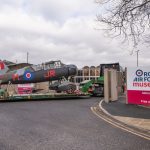By James Kightly, Commissioning Editor
The former Belgian Sabena Old Timers Westland Lysander Mk.IIIA V9546, registered OO-SOT, has been placed on the British civil register as G-LYZY on December 9, 2024, for the holding company of The Fighter Collection (TFC). This rare Lysander was the only continental European example airworthy through the 1990s, but was significantly damaged in a ground-loop on landing at Brussels Zaventem in July 2001, requiring a major rebuild. A Canadian sourced second airframe was obtained to enable the reconstruction.
While the aircraft was restored and ground run on September 13, 2008, apparently ready to fly, a number of factors conspired against the group – the bankruptcy of the Sabena airline business in 2001 had put a number of restrictions on the organization, including the aircraft being at risk of seizure as a company asset, and the ageing volunteer team (a problem for many similar organizations) was also an issue. Suitable certified types and engine issues were, apparently, never overcome and the aircraft has not flown.

A British, Westland, Yeovil-built Mk.IIIA example, it was supplied to the Royal Canadian Air Force in 1942, where it was used as a target tug, designated TT IIIA. Well-known collector Wes Agnew owned the Lizzie before it was acquired and stored by the Musee Royal de l’Armee, Brussels in 1971. Western European interest in the Lysander was in recognition the type plated as a ‘spy plane’ supporting the resistance organizations in the occupied nations. The Westland Lysander was designed as an army co-operation aircraft, but found fame in WWII flying in and extracting spies and agents across Western Europe, the Balkans, and even in the far east, becoming known as the ‘spy plane.’ Officially, the RAF operated aircraft were known as ‘Special Duties’ or SD aircraft, and were modified with long-range tanks and a boarding ladder, with the rear cabin able to accommodate two, or several more agents in a pinch.
The aircraft was acquired by the Sabena Old Timers Foundation in 1982, restored and flew again on August 27, 1988, incorporating parts from several Canadian built Lysanders. It flew as ‘2442’, (later V9367) MA-D (MA for 161 Squadron RAF) in Belgium, France and Britain at various airshows, and was repaired after a forced landing near Florennes, Belgium in 1988, but essentially disappeared from sight after the 2001 accident.

Currently there are two Lysanders airworthy in the UK, V9552 (painted as ‘V9367’ and registered G-AZWT) with the Shuttleworth Collection and V9312 (G-CCOM) with the Aircraft Restoration Co, and a third privately owned in Canada painted as ‘416’ C-FVZZ. A number more are on static display. All the survivors are Mk.I or Mk.III Bristol Mercury powered machines, and the limited supply of Mercury engine parts and users is a type issue. There has not been any further information released by TFC at this date.



























